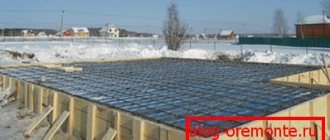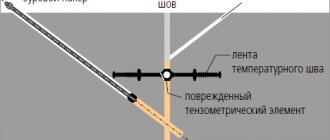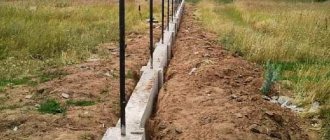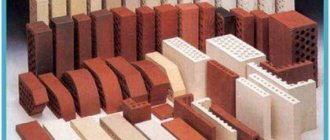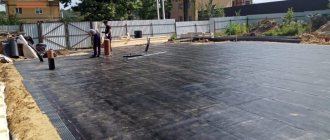The most ambitious project in the history of FORUMHOUSE, “A HOUSE IN A YEAR,” has been completed, and the happy family has already moved into a comfortable country house, which we and our partners built using the most modern materials and technologies. Construction began in February, and we had to concrete the USHP foundation in cold weather - this became possible thanks to the TECHNONICOL additive for winter concreting. Vasily Shramko, regional technical specialist in construction chemicals for concrete at TECHNONICOL Corporation, will tell you about the properties of antifreeze additives and the rules for its use in a master class format.
The principle of operation of the antifreeze additive
Most developers try to start building the foundation in the warm season, because the optimal temperature for hydration, the chemical reaction between cement and water, as a result of which setting occurs, is +15 - +20 degrees.
But often circumstances force us to start construction in the cold season, and besides, winter construction has its own benefits and advantages. When the average daily temperature drops to +5 degrees, building codes regulate the transition to winter work, and here the use of anti-frost additives is necessary.
Vasily Shramko regional technical specialist in construction chemicals for concrete at TECHNONICOL Corporation
The use of the additive is advisable when the ambient temperature drops below +5 degrees, because At low temperatures, the chemical reaction of cement with water practically stops.
In addition to the fact that the reaction between cement and water stops and, accordingly, worsens, and in some cases the setting of the solution stops, water, freezing, expands in volume and destroys the structure of concrete. If the concrete mixture freezes after being placed in the formwork, then it is pointless to wait for the required strength to gain after thawing. Its structure will be loose, and its strength will be significantly lower than the strength of concrete of the same composition, but not subjected to freezing.
Therefore, when constructing reinforced concrete structures and monolithic structures at temperatures below 0 degrees, antifreeze additives are used. They have an antifreeze effect and accelerate the setting and hardening of solutions at subzero temperatures.
Vasily Shramko
The action of the anti-frost additive is aimed at ensuring that the water included in the concrete mixture does not freeze, and the concrete structure gains its strength after laying.
The use of anti-frost additives allows the construction of foundations at temperatures from +5 to -25 degrees.
According to the principle of action, all antifreeze additives can be divided into two groups:
- Additives that lower the freezing point of the liquid phase of concrete; water does not turn into a solid state at -10 degrees and below.
- Additives that speed up the setting process.
When using additives in each of these categories, you must carefully read the manufacturer's instructions and also pay attention to the price tag. A cheap, low-quality antifreeze additive can worsen the performance of concrete.
Vasily Shramko
High-quality antifreeze additives include special components - corrosion inhibitors, which do not contain aggressive salts that corrode reinforcement. They can be used in reinforced concrete, incl. densely reinforced. Unfortunately, this cannot be said about all PMDs presented on the construction chemicals market. It all depends on the composition.
Antifreeze additives for concrete mortar
Concrete additives are used very often today, and anti-frost additives occupy a special place, as they allow work to be carried out almost all year round. The concrete mixture contains about 10% water and when the temperature drops, it begins to freeze. If, when the temperature drops, all processes in concrete simply slow down, then at minus temperatures, hardening stops altogether.
And then, when the process may continue during thawing, it already occurs with a violation of the technology, strength and resistance to mechanical loads, and other characteristics may decrease. To preserve the ability of the solution to gain strength, it is necessary to leave the water liquid even at minus temperatures, which is achieved using additives.
Plasticizer additives improve the dispersion of all solid components of the cement mortar. The friability of sand, gravel, and binder increases, the mixture becomes a suspension, and resistance to freezing increases to -15 degrees, and the hardening process usually accelerates.
The disadvantage of introducing such additives into concrete is the presence of chlorides in their composition, which can cause reinforcement to corrode. But some manufacturers offer additives without chlorides; they are better suited for pouring concrete with a reinforcing frame.
Difficulties of winter concreting
Any concrete solution is a mixture of a certain brand of cement, fine filler (quartz quarry or river sand), coarse filler (granite or limestone crushed stone, gravel) and water. All components are taken in a certain proportion, mixed thoroughly, and placed in a mold.
Next, the cement begins to interact with water (a hydration reaction occurs), begins to set and harden gradually (the process is completely completed after 28 days). Normally, this process takes place only at positive temperatures, but minus temperatures negatively affect the monolith.
What changes can occur in concrete under the influence of minus:
The hydration process takes noticeably longer – when the temperature drops below +5. At temperatures below 0, an ice crystal lattice forms in a liquid solution. During the freezing process, ice crystals increase in volume and cause the appearance of local stress zones in the still weak solution, as a result of which the structure is destroyed and breaks in the bonds of cement particles appear. When the concrete has already frozen, an ice crust appears around the metal parts, pushing the cement mass away from the steel reinforcement and thus compromising the integrity of the reinforced concrete products. When free water turns into ice, the volume of water decreases and then, when it thaws, it becomes insufficient for hydration.
All these phenomena are more dangerous the earlier the concrete freezes. If it has not reached at least 50% of its design strength, freezing can have a detrimental effect on quality and strength, significantly reducing performance.
Ways to combat solution freezing
The main task of winter concreting is to protect concrete solutions from freezing for as long as possible by keeping water in liquid form rather than ice. Several different methods are used for this.
Basic methods of combating freezing of concrete solutions:
The thermos effect - the formwork for pouring is created from heat-insulating materials, and the components themselves for preparing the solution are heated (liquid, sand and crushed stone, but not cement), then the mixture is poured and covered with heat-insulating materials. This way it is possible to prevent the concrete from freezing until the moment when the frost is no longer afraid of it.
Currently reading: Silicate concretes
Heating the solution in the formwork using different methods - steam, by passing current through it, using special devices. But this is a rather labor-intensive process and requires the use of special equipment. Creating a closed hut or canopy over the pouring site, heated by diesel or electric heat guns. Antifreeze is the introduction of antifreeze additives into the solution, which accelerate hydration and protect water from freezing.
The main advantages of antifreeze
Antifreeze additives can be dry or liquid. Liquids include ammonia water obtained by dissolving ammonia gas in water. The additive makes concrete frost-resistant, prevents reinforcement from corroding, and accelerates the hardening process of the monolith. Also on the market are a variety of solutions and universal mixtures made on the basis of dry substances. You can make an anti-frost additive to concrete with your own hands, but to do this you first need to understand the substances.
Types of dry additives in concrete mixture against frost:
Potash (aka potassium carbonate) – activates the hardening of concrete and lowers the freezing temperature. It is usually added to the composition with borax (sodium tetraborate), because in its pure form it reduces the strength indicator. The potash mixture sets quickly and is difficult to work with, so a superplasticizer is usually added. Sodium tetraborate - used alone or with potash, preserves the structure of concrete after thawing, reduces the water permeability of the monolith, increases strength and prevents cracks from appearing.
Sodium/calcium formate - significantly accelerates the hardening of concrete, working in a similar way to a plasticizer. Usually used with naphthalene lignosulfonate. The composition is introduced in a concentration of a maximum of 6% of the total mass of the solution. Sodium nitrite – lowers the freezing point of water in concrete, allowing the use of a non-freezing solution at temperatures from zero to -25 degrees.
What additives are added to complex formulations and how they are labeled:
NC – calcium nitrite; M – urea; CC – calcium chloride (prohibited for use in reinforced concrete); MNC – urea, calcium nitrate; P – potassium carbonate (potash).
High-quality industrial additives often perform several functions simultaneously: regulating the rate of strength gain, lowering the freezing temperature of the solution, accelerating reactions, changing the properties of the mixture.
What additional properties do the additives provide:
Increasing the mobility of the mixture, improving its distribution, reducing the volume of cement in the solution, increasing moisture resistance. Plasticizers based on organic polyacrylates, melamine resin sulfates or naphthalene have this effect. Significant increase in strength - strengthening additives based on iron and aluminum sulfates, calcium chloride and calcium nitrite. Protecting fittings from corrosion, extending the service life of products - corrosion-resistant additives. Mobility regulators significantly extend the time of working with the solution and prevent it from setting quickly. Complex action additives work in several directions at once.
The most effective is the use of ready-made liquid additives of complex action, which perform all the functions assigned to them and provide a lot of advantages. In Moscow and the regions it is not difficult to find mixtures; there are quite a lot of them on the market.
The main advantages of introducing antifreeze additives into the solution:
The freezing point of water in the mixture decreases. Plasticizers reduce density and increase mobility without the need to add excess liquid, which allows for better and more comfortable pouring of the solution. Corrosion inhibitors are often added to anti-freeze products to protect steel reinforcing elements from oxidation and destruction. The strength gain of concrete accelerates to a point after which various impacts are no longer dangerous. Increasing water resistance, as well as the design strength of the finished monolith. Allows you to save money compared to the use of other methods that provide the possibility of pouring concrete at a disadvantage.
Features of working with antifreeze additives
A do-it-yourself anti-freeze agent for concrete, provided the correct choice of substances and their volumes is used, can provide the same properties as an industrial mixture. But it is much easier to purchase a ready-made solution with the correct proportions and desired properties. It’s easy to work with additives, the main thing is to follow the technology.
How to work with anti-freeze for concrete:
Pour the required volume of water into the concrete mixer, pour anti-freeze liquid into it in the volume specified in the instructions. Allow the mixture to stir for 5-10 minutes. Without stopping stirring, load half the volume of sand into the container, then the entire volume of cement, then the rest of the sand. Load the entire volume of coarse filler into the concrete mixer and allow it to mix completely until the mixture is homogeneous. Develop the solution within the time specified in the instructions (the period may vary due to the properties of the additive).
How to use antifreeze additive
The additive manufacturer recommends the following sequence of actions for preparing a concrete mixture:
- Pour cement, sand and crushed stone into a mixing container and mix the components.
- Dilute the required amount of concrete additive in 5 liters of water.
- Pour the additive into the concrete mixture and mix thoroughly.
- If necessary, add water to the mixture (no more than 4 liters).
Some developers believe that antifreeze liquid can be added to the mixer on site, but the expert recommends being on the safe side.
Vasily Shramko
It is better to order a mixer with an anti-frost additive to the site.
Because it is correct to add anti-freeze liquid with water during the preparation of the concrete mixture.
Vasily Shramko
The additive dissolves in water, which is necessary for preparing the concrete mixture. By doing this, we minimize the risks of introducing excess water into concrete, which can reduce the strength properties of concrete. When preparing the mixture, there are no special requirements for water quality. Typically, at a concrete plant in winter, steam generators are turned on to heat the inert material. The water for making concrete is also heated (from 20 to 40C), since the temperature of the concrete mixture to be laid must not be lower than +10 degrees.
Specifics of use
Additives to the solution provide the required effect, subject to the percentage concentration. If the recipe is not followed or additives are introduced that deviate from the manufacturers' recommendations, the hydration process will stop and the cement will freeze.
When the temperature increases by 4-5 degrees Celsius, the hydration process will resume, but the structure of the concrete mass will change, which will affect the strength characteristics.
Due to the high strength of products made using anti-frost additives in concrete, they can be used for industrial purposes
Antifreeze additives introduced in the required quantities improve water resistance, increase density, slow down corrosion processes, and also increase the strength of the massif.
An important feature of the use of antifreeze ingredients is compliance with safety requirements. Sodium nitrate and potash used at subzero temperatures are poisonous and dangerous to human health components. It is unacceptable to get them on the skin, as well as on the mucous membrane.
When using frost-resistant additives in a concrete mixture, use special overalls, gloves to protect your hands, and goggles. Ensure that substances are stored indoors.
How to calculate the dosage of antifreeze liquid
When selecting the composition of a concrete mixture, it is necessary to take into account the technical characteristics of the materials used. The quality of inert materials will determine the amount of cement consumption, the ratio of sand and crushed stone, and the possibility of designing high-quality concrete. Cement is of great importance for concrete: its activity, grinding fineness, hardening speed, etc. But an incorrectly calculated dosage of an antifreeze additive can negatively affect the quality of concrete; additives should not be abused.
The amount of antifreeze liquid in the solution depends on the amount of cement and air temperature.
Vasily Shramko
The dosages of our product are very simple: for every -5 degrees you need to add approximately 3 liters of additive per cube of concrete (you can find out more about the dosage in the instructions for use on the label). Thus, the consumer insures his structure against freezing and can be sure that the concrete he placed in the structure will show the required strength.
Dosage of antifreeze additive required for concrete to gain the required strength
| up to -5°С - 1% | 1 kg of additive per 100 kg of cement |
| up to -10°С - 2% | 2 kg of additive per 100 kg of cement |
| up to -15°C - 3% | 3 kg of additive per 100 kg of cement |
| up to -20°С - 4% | 4 kg of additive per 100 kg of cement |
| up to -25°С - 5% | 5 kg of additive per 100 kg of cement |
We must not forget that in the cold season, while negative temperatures persist, the strength of concrete with antifreeze additives does not exceed 30% of the possible design strength.
Vasily Shramko
According to GOST 24211, the strength gain of “cold” concrete must be at least 30% of its brand strength 28 days after laying. Concrete will reach the remaining grade flowability at above-zero temperatures. Concrete can be loaded when it reaches 70% brand strength. Under “normal” conditions, this occurs 7 days after laying the concrete. Accordingly, at a temperature of +5 C, concrete will not reach 70% strength without additional heating. The use of high-quality plasticizing additives allows you to speed up this process
The formwork can be removed from the structure when the concrete reaches 30% of its grade.
Why low temperatures prevent concrete from gaining strength
During the hydration reactions that occur in the concrete mixture, strong crystalline compounds are formed. But for these reactions to occur fully, certain conditions are necessary:
- ambient temperature +18–22° C;
- almost one hundred percent air humidity.
It is especially important to comply with these conditions during the period of critical strength gain. It is indicated in the design documentation and amounts to 30–50% of the design strength of concrete. Usually this indicator is achieved on the 4th–6th day of concrete hardening. Further conditions may not be optimal.
When mixed, the concrete mixture contains a fairly large amount of water, which has not yet reacted with the cement, and this situation continues until the concrete reaches critical strength. If at this time the ambient temperature decreases, the rate of hydration reactions also decreases, and at temperatures below +5°C, hardening practically stops. At negative temperatures, the water in the mixture freezes and hydration reactions stop, therefore, the hardening of concrete stops.
What problems arise at low temperatures:
- hydration reactions slow down or stop altogether;
- freezing of the material leads to its expansion and an increase in internal pressure;
- Ice crystals form around the reinforcement, which weakens the adhesion of concrete to the reinforcement.
All this leads to low quality concrete products.
Important!
If concrete has not reached critical strength and is frozen, after thawing it will begin to harden again, but will ultimately be less strong. Concrete that has reached critical strength can already be subjected to freezing. After thawing it will gain strength.
How to properly use antifreeze additives
As we have already said, the role of antifreeze additives in winter concreting is that they activate hardening processes and lower the freezing point of the liquid phase. The rest depends on the builder himself.
Vasily Shramko
After laying the freshly laid mixture, it is necessary to carry out a number of measures to care for the concrete. SNiP 7013330.
- The mixture is prepared from heated materials to create a warm and moist environment, the necessary conditions for concrete hardening.
- To maintain this warm and humid environment for a long time, the surface of the concrete should be insulated after placement. Concrete insulated from cold air by shields and mats will generate additional heat during the hardening process. At different construction sites, depending on their characteristics, and in structures of different volumes, this exothermic reaction will occur with different intensities.
- If you immediately cover the exposed surface with waterproofing material after concreting, this will help avoid not only moisture loss, but also the formation of efflorescence.
- It is not recommended to pour during snowfall, and if snow starts during this process, then the already laid concrete is urgently covered with a layer of waterproofing.
When performing work involving the use of antifreeze liquid, you should be careful and use gloves and goggles. It is prohibited to pour out PMD residues onto the ground, into sewers or water bodies.
